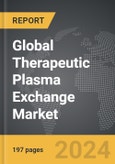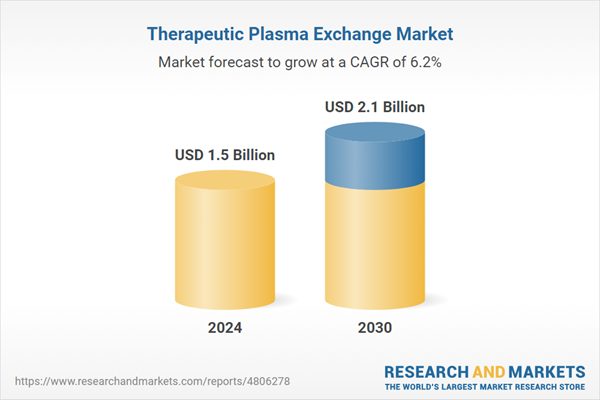Global Therapeutic Plasma Exchange Market - Key Trends and Drivers Summarized
What Makes Therapeutic Plasma Exchange Critical in Modern Healthcare?
Therapeutic plasma exchange (TPE) has emerged as a life-saving procedure in treating various autoimmune diseases, hematological conditions, and neurological disorders. This procedure involves the removal of plasma from a patient's blood and its replacement with fresh plasma or a plasma substitute, which helps eliminate harmful antibodies and toxins. The increasing use of TPE in treating conditions such as Guillain-Barré syndrome, myasthenia gravis, and multiple sclerosis has underscored its critical role in healthcare. As awareness of the benefits of plasma exchange grows, more patients and healthcare providers are turning to this therapy, which has significantly expanded the therapeutic plasma exchange market in recent years.How Are Different Applications and Technologies Driving the Market?
By technology, centrifugal-based and membrane filtration techniques are the most commonly employed methods, each offering distinct advantages. Centrifugal-based systems are widely used in treating neurological conditions, whereas membrane filtration is preferred for renal disorders and certain hematological diseases. Disease indication segments range from autoimmune disorders to blood dyscrasias and other critical illnesses. In terms of end-users, hospitals, specialty clinics, and blood donation centers dominate the market, with a growing number of outpatient facilities adopting TPE procedures for chronic disease management. The rising number of treatment options that incorporate TPE is expanding the market's overall reach.What Innovations Are Shaping the Future of Therapeutic Plasma Exchange?
Technological advancements have led to more efficient, safe, and user-friendly plasma exchange systems, making the procedure more accessible to healthcare providers. Automated apheresis devices, equipped with enhanced safety features, are increasingly becoming the standard of care, reducing procedure time and improving patient outcomes. Moreover, the integration of real-time monitoring and data analytics in TPE systems allows healthcare providers to customize treatments based on patient-specific conditions. Additionally, the growing trend of combining therapeutic plasma exchange with other treatment modalities, such as immunosuppressive therapies, is transforming the landscape of chronic disease management.What Are the Key Drivers of Growth in the Therapeutic Plasma Exchange Market?
The growth in the therapeutic plasma exchange market is driven by several factors, including the rising prevalence of autoimmune diseases, the increased use of TPE in treating neurological conditions, and the growing number of regulatory approvals for novel plasma exchange devices. Technological innovations in apheresis devices, coupled with rising investments in healthcare infrastructure, are expanding the adoption of TPE. Additionally, increasing awareness among healthcare professionals about the benefits of early intervention with TPE in critical care settings is boosting the demand for plasma exchange. The expanding base of patients eligible for TPE, particularly in the treatment of rare and complex disorders, further propels market growth. Lastly, the development of portable and more cost-effective plasma exchange systems is expected to make this life-saving therapy more accessible, driving market expansion in the coming years.Report Scope
The report analyzes the Therapeutic Plasma Exchange market, presented in terms of market value (US$ Thousand). The analysis covers the key segments and geographic regions outlined below.- Segments: Disease Indication (Neurological Disorders, Renal Disorders, Hematology Disorders, Metabolic Disorders, Other Disease Indications); End-Use (Hospitals, Specialty Clinics, Ambulatory Surgery Centers).
- Geographic Regions/Countries:World; United States; Canada; Japan; China; Europe (France; Germany; Italy; United Kingdom; and Rest of Europe); Asia-Pacific; Rest of World.
Key Insights:
- Market Growth: Understand the significant growth trajectory of the Neurological Disorders Indication segment, which is expected to reach US$789.6 Million by 2030 with a CAGR of a 6.9%. The Renal Disorders Indication segment is also set to grow at 5.3% CAGR over the analysis period.
- Regional Analysis: Gain insights into the U.S. market, valued at $410.1 Million in 2024, and China, forecasted to grow at an impressive 5.7% CAGR to reach $331.7 Million by 2030. Discover growth trends in other key regions, including Japan, Canada, Germany, and the Asia-Pacific.
Why You Should Buy This Report:
- Detailed Market Analysis: Access a thorough analysis of the Global Therapeutic Plasma Exchange Market, covering all major geographic regions and market segments.
- Competitive Insights: Get an overview of the competitive landscape, including the market presence of major players across different geographies.
- Future Trends and Drivers: Understand the key trends and drivers shaping the future of the Global Therapeutic Plasma Exchange Market.
- Actionable Insights: Benefit from actionable insights that can help you identify new revenue opportunities and make strategic business decisions.
Key Questions Answered:
- How is the Global Therapeutic Plasma Exchange Market expected to evolve by 2030?
- What are the main drivers and restraints affecting the market?
- Which market segments will grow the most over the forecast period?
- How will market shares for different regions and segments change by 2030?
- Who are the leading players in the market, and what are their prospects?
Report Features:
- Comprehensive Market Data: Independent analysis of annual sales and market forecasts in US$ Million from 2024 to 2030.
- In-Depth Regional Analysis: Detailed insights into key markets, including the U.S., China, Japan, Canada, Europe, Asia-Pacific, Latin America, Middle East, and Africa.
- Company Profiles: Coverage of players such as Asahi Kasei Medical Co., Ltd., B. Braun Melsungen AG, Baxter International, Inc., Fenwal, Inc., Fresenius SE & Co. KGaA and more.
- Complimentary Updates: Receive free report updates for one year to keep you informed of the latest market developments.
Some of the 47 companies featured in this Therapeutic Plasma Exchange market report include:
- Asahi Kasei Medical Co., Ltd.
- B. Braun Melsungen AG
- Baxter International, Inc.
- Fenwal, Inc.
- Fresenius SE & Co. KGaA
- Haemonetics Corporation
- HemaCare Corporation
- Kawasumi Laboratories, Inc.
- Terumo BCT, Inc.
This edition integrates the latest global trade and economic shifts into comprehensive market analysis. Key updates include:
- Tariff and Trade Impact: Insights into global tariff negotiations across 180+ countries, with analysis of supply chain turbulence, sourcing disruptions, and geographic realignment. Special focus on 2025 as a pivotal year for trade tensions, including updated perspectives on the Trump-era tariffs.
- Adjusted Forecasts and Analytics: Revised global and regional market forecasts through 2030, incorporating tariff effects, economic uncertainty, and structural changes in globalization. Includes historical analysis from 2015 to 2023.
- Strategic Market Dynamics: Evaluation of revised market prospects, regional outlooks, and key economic indicators such as population and urbanization trends.
- Innovation & Technology Trends: Latest developments in product and process innovation, emerging technologies, and key industry drivers shaping the competitive landscape.
- Competitive Intelligence: Updated global market share estimates for 2025, competitive positioning of major players (Strong/Active/Niche/Trivial), and refined focus on leading global brands and core players.
- Expert Insight & Commentary: Strategic analysis from economists, trade experts, and domain specialists to contextualize market shifts and identify emerging opportunities.
Table of Contents
Companies Mentioned (Partial List)
A selection of companies mentioned in this report includes, but is not limited to:
- Asahi Kasei Medical Co., Ltd.
- B. Braun Melsungen AG
- Baxter International, Inc.
- Fenwal, Inc.
- Fresenius SE & Co. KGaA
- Haemonetics Corporation
- HemaCare Corporation
- Kawasumi Laboratories, Inc.
- Terumo BCT, Inc.
Table Information
| Report Attribute | Details |
|---|---|
| No. of Pages | 197 |
| Published | December 2025 |
| Forecast Period | 2024 - 2030 |
| Estimated Market Value ( USD | $ 1.5 Billion |
| Forecasted Market Value ( USD | $ 2.1 Billion |
| Compound Annual Growth Rate | 6.2% |
| Regions Covered | Global |









